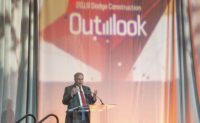At a seasonally adjusted annual rate of $629.4 billion, new construction starts in July were essentially unchanged from June’s pace, according to Dodge Data & Analytics. By major sector, nonresidential building showed slight improvement following its lackluster June performance while residential building maintained the strengthening trend witnessed over the past several months.
At the same time, nonbuilding construction in July continued to slide back from the exceptional activity witnessed earlier in the year that reflected the start of very large projects, including several massive liquefied natural gas terminals.
Through the first seven months of 2015, total construction starts on an unadjusted basis were $397.0 billion, up 19% from the same period a year ago. Leaving out the volatile electric utility and gas plant category, total construction starts during the first seven months of 2015 would be up a more moderate 10% from the same period a year ago.
The latest month’s data kept the Dodge Index at 133 (2000=100), the same as June’s upwardly revised reading. While June and July were at the low end of what’s been reported so far in 2015, with the Dodge Index ranging from 133 to 156, they were still above the 125 average for 2014 as a whole.
“The first half of 2015 showed wide swings in the pattern of total construction starts, affected by the presence or absence of unusually large projects,” said Robert A. Murray, chief economist for Dodge Data & Analytics. “Amidst these top-line swings, the underlying trend of activity has been generally upward relative to last year. For nonresidential building, support has come primarily from its institutional segment, including educational facilities, transportation-related buildings and amusement and recreational facilities.
“The commercial categories showed some deceleration during the early months of 2015, but positive real estate market fundamentals are expected to encourage renewed growth,” Murray said. “Residential building has benefitted from this year’s heightened amount of multifamily starts, and even the single-family side of the market is showing some hesitant signs of strengthening.
“The nonbuilding construction sector experienced robust activity during the opening months of 2015, for the most part related to the start of unusually large projects, and it now appears to be settling back to a more sustainable pace. The improved performance of the U.S. economy in the second quarter of 2015, with GDP rising 2.3% after a very weak first quarter, should help both nonresidential building and housing going forward.
Nonbuilding construction will be helped in the near term by Congress recently passing a stopgap, three-month $8-billion surface transportation extension,” Murray added.
Nonresidential Building
Nonresidential building in July increased 2% to $194.0 billion (annual rate). The commercial categories as a whole bounced back 12% in July, after retreating by the same percentage amount in June. Office construction climbed 7% in July, reflecting groundbreaking for several noteworthy projects. They included the $232-million Bridgestone Americas office tower in Nashville; the $150-million Seaport Tower in Boston; a $100-million data center in Lowell, Mass.; and a $100-million portion of the Toyota Corporate Campus in Plano, Texas.
“During the first half of 2015, office construction appeared to level off after its substantial 35% gain in 2014,” Murray said. “On the positive side, office vacancy rates continued to recede through this year’s second quarter, the volume of office construction is still quite low by historical standards, and the July pickup in construction starts may well be an indication of renewed growth to come.”
Store construction in July improved 6%, helped by the start of the $40-million Wade Park Shopping Center in Frisco, Texas. Warehouse construction in July rebounded 28% after a weak June and included groundbreaking for a $48-million Home Goods distribution center in Tucson, Ariz.
Hotel construction, which has been the one commercial property type to register healthy year-to-date percentage growth, slipped 4% in July. The latest month still included the start of several large hotel projects, such as the $79-million phase 2 of the Kalahari Resort and Water Park in Pocono Manor, Pa.; the $76-million renovation of the Atlanta Marriott Marquis Hotel in Atlanta; and the $75-million hotel portion of the $175-million Hilton Statler Hotel and Residences in Dallas.
New manufacturing plant construction starts were generally subdued in July, falling 39% from June, and substantially lower than the elevated amounts back in February and April that featured the start of several huge petrochemical plants.
The institutional building group in July eased back 1%, receding for the second month in a row after improved activity earlier in 2015. The educational facilities category dropped 20% after strengthening during the previous three months.
Even with the decline, July included the start of such projects as a $162-million research and development building in Cambridge, Mass., and a $112-million elementary and middle school campus in Seattle. Health care facilities in July fell 15%, maintaining the up-and-down pattern that’s been present in 2015, even with the July start of a $250-million hospital tower in Provo, Utah.
The smaller institutional categories all registered gains in July. Transportation-related buildings jumped 120%, helped by the start of a $200-million rail service facility in Croton On Hudson, N.Y. The amusement and recreational building category climbed 49%, helped by the start of a $130-million student center at the University of Kentucky in Lexington and a $123-million music hall renovation in Cincinnati.



Post a comment to this article
Report Abusive Comment